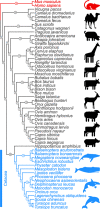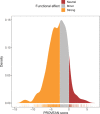Comparative genomics of cetartiodactyla: energy metabolism underpins the transition to an aquatic lifestyle
- PMID: 33505701
- PMCID: PMC7816800
- DOI: 10.1093/conphys/coaa136
Comparative genomics of cetartiodactyla: energy metabolism underpins the transition to an aquatic lifestyle
Abstract
Foraging disruption caused by human activities is emerging as a key issue in cetacean conservation because it can affect nutrient levels and the amount of energy available to individuals to invest into reproduction. Our ability to predict how anthropogenic stressors affect these ecological processes and ultimately population trajectory depends crucially on our understanding of the complex physiological mechanisms that detect nutrient availability and regulate energy metabolism, foraging behavior and life-history decisions. These physiological mechanisms are likely to differ considerably from terrestrial mammalian model systems. Here, we examine nucleotide substitution rates in cetacean and other artiodactyl genomes to identify signatures of selection in genes associated with nutrient sensing pathways. We also estimated the likely physiological consequences of adaptive amino acid substitutions for pathway functions. Our results highlight that genes involved in the insulin, mTOR and NF-ĸB pathways are subject to significant positive selection in cetaceans compared to terrestrial artiodactyla. These genes may have been positively selected to enable cetaceans to adapt to a glucose-poor diet, to overcome deleterious effects caused by hypoxia during diving (e.g. oxidative stress and inflammation) and to modify fat-depot signaling functions in a manner different to terrestrial mammals. We thus show that adaptation in cetaceans to an aquatic lifestyle significantly affected functions in nutrient sensing pathways. The use of fat stores as a condition index in cetaceans may be confounded by the multiple and critical roles fat has in regulating cetacean metabolism, foraging behavior and diving physiology.
Keywords: Cetaceans; NF-ĸB; energy metabolism; evolution; insulin; mTOR.
© The Author(s) 2021. Published by Oxford University Press and the Society for Experimental Biology.
Figures







Similar articles
-
Genetic signatures of lipid metabolism evolution in Cetacea since the divergence from terrestrial ancestor.J Evol Biol. 2018 Nov;31(11):1655-1665. doi: 10.1111/jeb.13361. Epub 2018 Aug 21. J Evol Biol. 2018. PMID: 30074670
-
Comparative analysis of the superoxide dismutase gene family in Cetartiodactyla.J Evol Biol. 2021 Jul;34(7):1046-1060. doi: 10.1111/jeb.13792. Epub 2021 Jun 9. J Evol Biol. 2021. PMID: 33896059
-
Distinct evolution of toll-like receptor signaling pathway genes in cetaceans.Genes Genomics. 2019 Dec;41(12):1417-1430. doi: 10.1007/s13258-019-00861-3. Epub 2019 Sep 18. Genes Genomics. 2019. PMID: 31535317
-
Cetacean brains: how aquatic are they?Anat Rec (Hoboken). 2007 Jun;290(6):694-700. doi: 10.1002/ar.20530. Anat Rec (Hoboken). 2007. PMID: 17516433 Review.
-
The evolution of foraging capacity and gigantism in cetaceans.J Exp Biol. 2018 Jun 12;221(Pt 11):jeb166033. doi: 10.1242/jeb.166033. J Exp Biol. 2018. PMID: 29895582 Review.
Cited by
-
A review of bioenergetic modelling for marine mammal populations.Conserv Physiol. 2022 Jun 21;10(1):coac036. doi: 10.1093/conphys/coac036. eCollection 2022. Conserv Physiol. 2022. PMID: 35754757 Free PMC article.
-
Lifespan Extension in Long-Lived Vertebrates Rooted in Ecological Adaptation.Front Cell Dev Biol. 2021 Oct 18;9:704966. doi: 10.3389/fcell.2021.704966. eCollection 2021. Front Cell Dev Biol. 2021. PMID: 34733838 Free PMC article. Review.
-
Estimating energetic intake for marine mammal bioenergetic models.Conserv Physiol. 2023 Feb 4;11(1):coac083. doi: 10.1093/conphys/coac083. eCollection 2023. Conserv Physiol. 2023. PMID: 36756464 Free PMC article.
-
Metabolic response of dolphins to short-term fasting reveals physiological changes that differ from the traditional fasting model.J Exp Biol. 2021 May 1;224(9):jeb238915. doi: 10.1242/jeb.238915. Epub 2021 May 4. J Exp Biol. 2021. PMID: 33766933 Free PMC article.
-
Alterations of pleiotropic neuropeptide-receptor gene couples in Cetacea.BMC Biol. 2024 Sep 2;22(1):186. doi: 10.1186/s12915-024-01984-0. BMC Biol. 2024. PMID: 39218857 Free PMC article.
References
-
- Arkan MC, Hevener AL, Greten FR, Maeda S, Li Z-W, Long JM, Wynshaw-Boris A, Poli G, Olefsky J, Karin M (2005) IKK-beta links inflammation to obesity-induced insulin resistance. Nat Med 11: 191–198. - PubMed
LinkOut - more resources
Full Text Sources
Other Literature Sources
Miscellaneous

